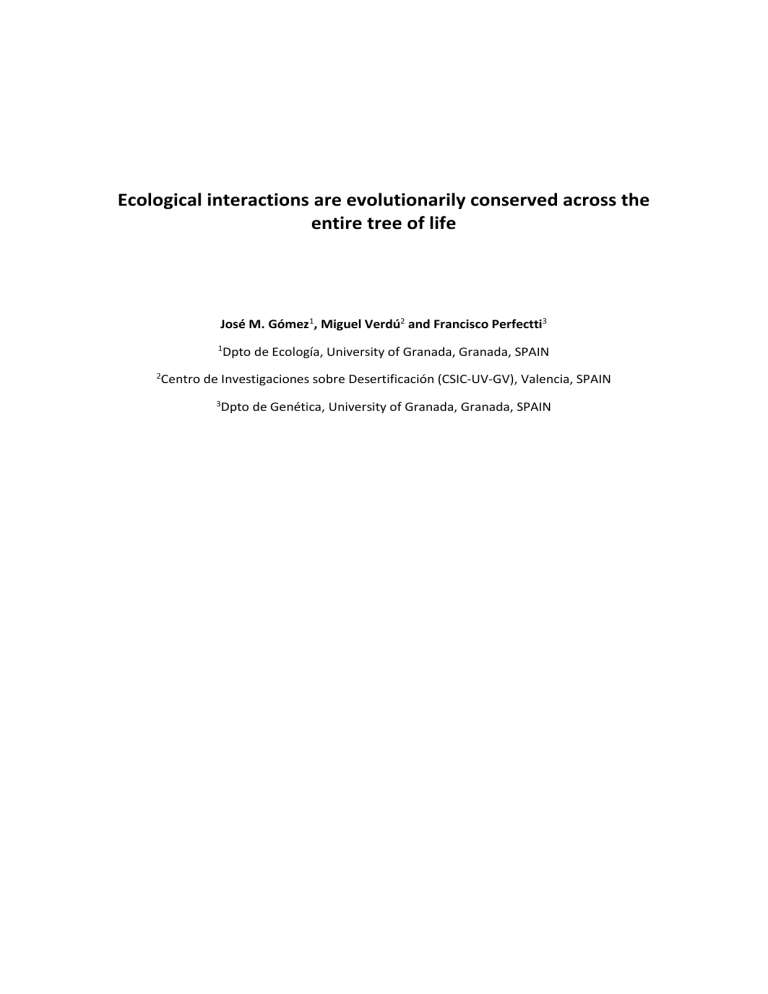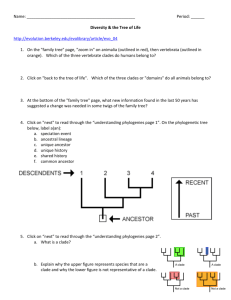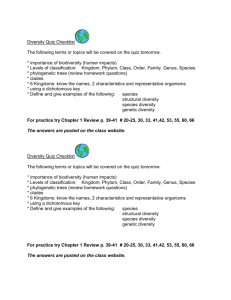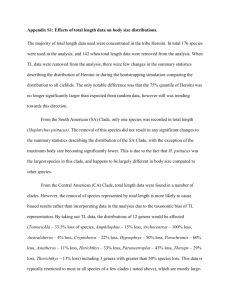The evolutionary history of ecological interactions - digital

Ecological interactions are evolutionarily conserved across the entire tree of life
José M. Gómez 1 , Miguel Verdú 2 and Francisco Perfectti 3
1 Dpto de Ecología, University of Granada, Granada, SPAIN
2 Centro de Investigaciones sobre Desertificación (CSIC-UV-GV), Valencia, SPAIN
3 Dpto de Genética, University of Granada, Granada, SPAIN
Ecological interactions are crucial to understand both the ecology and evolution of organisms 1-2 . Since the phenotypic traits regulating species interactions are largely a legacy of their ancestors, it is widely assumed that ecological interactions are phylogenetically conserved, with closely related species interacting with similar partners 2 . However, the existing empirical evidence is inadequate to appropriately evaluate the hypothesis of phylogenetic conservatism in ecological interactions because it is both ecologically and taxonomically biased. In fact, most studies on the evolution of ecological interactions have focused on specialized organisms, such as some parasites or insect herbivores 3-7 , belonging to a limited subset of the overall tree of life. Here we study the evolution of host use in a wide and diverse group of interactions comprising both specialist and generalist acellular, unicellular and multicellular organisms. We show that generalized interactions, as previously found for specialized ones, can also be evolutionarily conserved. Significant phylogenetic conservatism of interaction patterns was equally likely to occur in symbiotic and nonsymbiotic interactions, as well as in mutualistic and antagonistic interactions. Host use differentiation among species was higher in phylogenetically-conserved clades, irrespective of their generalization degree and taxonomic position within the tree of life. Our findings strongly suggest a shared pattern in the organization of biological systems through evolutionary time, mediated by marked conservatism of ecological interactions among taxa.
Shared ancestry may produce ecological similarity, with closely related species showing similar ecological niches 8 . The idea, rather than being new, may be traced back to Darwin’s famous statement that struggle for existence is most severe among related species because they have similar phenotypes and niche requirements 9 . Interspecific interactions comprise a substantial part of the niche of most species 10 . Conventional wisdom suggests that two closely related species should be more likely to interact with similar organisms than would species that are remotely-related, because the phenotypic traits that regulate the interactions are often phylogenetically conserved 3-7 . It is thereby widely assumed that, as with other niche components, ecological interactions are evolutionarily conserved 2,7 .
We explored this idea compiling information from 116 clades belonging to 7 Kingdoms
(Euryarchaeota, Bacteria, Excavata, Chromalveolata, Fungi, Plantae and Animalia) from the three cellular Domains (Archaea, Eubacteria and Eucarya) and RNA and DNA viruses
(Supplementary Appendix 1). We chose these systems because (1) they contain all types of ecological interactions, from antagonism (i.e., endophytic herbivory, folivory, parasitism) to mutualism (i.e., pollination, mycorrhiza, seed dispersal, N-fixing); (2) by exploring organisms from disparate portions of the tree of life, our data set avoids taxonomic and systematic biases; (3) they comprise a wide range of generalization/specialization degree; (4) reliable records of interacting organisms (hereafter, referred to as hosts for the sake of simplicity) are available for those clades; and (5) phylogenetic trees are available (Online Supplementary
Appendix 1). We have used genus as our target clade level because it is the taxonomic level at which interaction-mediated speciation mostly manifest 2,7 . Similarly, the taxonomic resolution of the hosts was determined by the information available for each studied system (see Online
Full Methods). However to check whether this may represent a source of bias in our study, we included this information as covariate in all subsequent analyses.
The host range of the studied clades, calculated as the average number of organisms interacting with each species of that clade, varied from 1 (extreme specialization) to 11.2. That is, we worked with systems ranging from those in which all species interacted with only a single host to those in which the species interacted on average with more than 10 hosts.
Nevertheless, within most systems there were species interacting with many hosts (up to 50) coexisting with species interacting with very few hosts (Supplementary Appendix 1). We categorized the studied clades as specialists, having a host range < 1.5 hosts/species, and
generalists, those having host ranges ≥ 1.5 host/species. 58% (N= 67) of the studied clades were specialist and 42% (N=49) were generalist. Specialization depended significantly on taxonomic affiliation (Table S1). As many as 95% of the viruses were specialist (host range:
1.30± 0.29 host/species, N = 21 clades), whereas only 53% of the eukaryotes (host range: 2.55
± 0.25; N = 76 clades) and 48% of the prokaryotes (host range: 1.87 ± 0.30, N = 19 clades, pooling Archaea and Eubacteria) were specialist. No other system characteristic (interaction intimacy, interaction sign, number of species per genus, number of species actually studied per genus or sampling effort) affected specialization degree (Table S1), suggesting that our distribution of host range across genera was not biased by the sampling intensity of the original data set.
Tracking the evolutionary history of specialized interactions is not difficult, and has been performed for different kinds of interaction, from mutualism (i.e., pollination, dispersal) to antagonism (i.e., herbivory, parasitism). It can be explored by directly mapping host shift across the phylogeny of the focal clade. Because in extremely specialized clades the host range is very narrow, it is easy to draw the identity of the host for each species in the phylogeny and to quantify host shifts and host conservatism. Specialized interactions are conserved when there is nonindependence in host use among species within a clade due to their phylogenetic relatedness. This can be tested by estimating the degree of phylogenetic signal, which is the tendency for related species to resemble each other in interaction patterns more than species randomly drawn from the phylogenetic tree do 11 . However, the use of this approach becomes increasingly difficult, to the point of becoming unfeasible, as the diversity of organisms interacting with the focal clade increases. As stated above, more than 50% of the studied clades were generalist, showing host ranges higher than 1.5 per species.
Generalist species interact with many other species, and therefore form networks of interacting organisms. Network analysis has been successfully and extensively used during the last decade to analyze complex ecological interactions 12-13 . Based on the pattern of shared interactions, species can be grouped in compartments or modules. Species are tightly linked if they share a high proportion of interactions, that is, if they are ecologically similar. Groups of species interacting with similar organisms would form modules within the general network 14-15 .
Significant modularity emerges in a network when distinct groups of species closely share links with each other more than with species in other modules 16 . Using a network approach, we explore the evolution of ecological interactions by tracking the changes in module affiliation across the phylogenies (Fig. 1). Several recent studies have quantified the effect of phylogenetic structure on the dynamics of ecological communities 17-18 . However, rather than following the standard community perspective to build networks, we use clade-oriented networks (i.e., groups of phylogenetically-related species sharing a common ancestor but not necessarily co-occurring in the same locality). For extremely specialized clades, those showing high host specificity, the modules contain the group of species interacting with the same host
(Fig. 1a). Exploring phylogenetic conservatism in module ascription is analogous in these types of systems to exploring phylogenetic conservatism in host use using the standard methodology. In clades in which species interact with more than one host, establishing out modules of species sharing similar hosts allows for the exploration of phylogenetic conservatism even when it is not possible to group species according to their exact equivalence in host use (Fig 1b). Under this perspective, ecological interactions are conserved if a phylogenetic signal occurs in module affiliation. In short, this method allows the exploration of evolutionary conservatism of ecological interactions in all types of systems, irrespective of their degree of generalization or host specificity.
For each clade we built a network as described above (Fig. 1), including as nodes only the species for which host use is accurately known. In these networks, species were linked
when they shared at least one host. As interacting organisms, we used the most accurate taxonomic resolution used in the original studies (Supplementary Information). We then used simulated annealing to establish significant modules within each network 14-15 . A modular network implies that the clade is made up of species that can be grouped according to their affinity in host use. All but six clades (Echium, Chlamydia, Iochroma, Mycobacterium,
Onthophagus, Terfezia) were significantly modular, indicating that species can be grouped within a given clade based on their similarity in host use, and this modularity is evident in generalized as well as in specialized clades (Table S2). It is easy to identify the hosts associated with each module in specialized clades (Fig S1). In contrast, in generalized clades modules are defined by the shared use of several hosts (Fig. S1). To overcome this problem, we quantified between-module differences in host composition by using a multivariate ANOVA based on species-composition dissimilarity (ADONIS 19 ), a standard approach in community ecology. We found that the modules of all studied clades, both specialist and generalist, differed significantly in the identity and composition of the host assemblage (p<0.01 for all systems,
Table S3). More interestingly, modules within a network did not differ among themselves in the number of hosts (p>0.05 for most systems, after Bonferroni correction; Table S3), meaning that the emergence of modules in generalized clades was not due to differences in host range across species. Only eleven out of the 116 studied systems (Arceuthobium, Asclepias, Curculio,
Encarsia, Ficus, Geosmithia, Gonioctena, Morbillivirus, Mycobacterium, Rickettsia, and
Tetratrichomonas) showed significant differences in host range among modules (Table S3). All together, these results show that modules describe distinct and discrete interactive niches both in specialized and generalized clades.
The number of modules in a given network may be considered a measured of the diversity of interactive niches occupied by the genus. The number of modules per network ranged between 2 and 20 (5.52 ± 0.36). It was affected by the interaction intimacy (symbiotic vs. non-symbiotic systems), with symbiotic genera having more modules (6.2 ± 0.5, n =75 clades) than non-symbiotic ones (4.2± 0.4, n = 40 clades). The number of modules was negatively related to host range, even after controlling for number of species in the clade
(Table S4). This means that the number of distinct interacting niches is higher in specialized genera than in generalized ones. In addition, Domain also affected the number of modules per system (Table S4), with viruses and prokaryotes having more modules per clade than eukaryotes (Table S5). This may reflect a trend towards greater diversification of ecological niches in microorganisms.
Simulated annealing produces a modularity index “M” that estimates how clearly delimited the modules are 15 (see Methods). This index depends on the number of betweenmodule links relative to the number of within-module links, and decreases when the fraction of between-module links increases in the total network. In the context of ecological interactions, this means that M is negatively related to the proportion of species belonging to different modules but sharing hosts. Consequently, it can be used as an estimate of the between-module differentiation in host use. Low values of M would indicate no differentiation because many hosts are shared between different modules and high values of M would indicate differentiation because the modules do not use common hosts. The extreme situation is exemplified by those genera where most modules are completely isolated without any links with the remaining modules (high differentiation in host use; see Figure S1). Modularity ranged in our data set between 0 and 0.833 (Appendix S1). M was higher in specialist clades
(0.390 ± 0.026) than in generalist ones (0.232 ± 0.030). There was indeed a significant negative relationship between modularity and host range across clades (Table S4). This means that between-module differentiation in host use decreases with the generalization of the clades. In fact, in community networks modularity is expected to increase with host specificity 16 .
Similarly, M was higher in symbiotic (0.363 ± 0.030) than in non-symbiotic clades (0.239 ±
0.034; Table S3), probably because symbionts tend to be more specialized (host range= 1.77 ±
0.17) than non-symbionts (host range = 2.95 ± 0.40) (F = 9.63, df = 1,108, p = 0.002), and share fewer hosts between modules. This association between interaction intimacy, generalization degree and network metrics has been previously shown for 19 ant-plant mutualistic networks 20 .
To explore how evolutionarily conserved ecological interactions are, we statistically tested whether phylogenetically-related species were more prone to belong to the same module than expected randomly (i.e., we tested for phylogenetic signal of ecological interactions) 21 . We found that over 83% of the specialist clades showed significant phylogenetic signal for host use (Appendix S1). More important, 52% of the generalist clades also showed significant phylogenetic signal (Appendix S1). In fact, no effect of host range was found on the probability of having significant phylogenetic conservatism in ecological interaction (Fig 2, Table S6). Similarly, the occurrence of conservatism in ecological interactions did not depend on the sign of the interaction (Table S6), since 69% of antagonistic systems and
59% of mutualistic systems had significant phylogenetic signals. That is, parasites and predators have the same probability of having phylogenetically-conserved ecological interactions as pollinators, seed dispersers or mycorrhizae. Phylogenetic conservatism in antagonistic interactions is expected under most macro-coevolutionary models, such as escape and radiation model, parallel cladogenesis, sequential evolution or diversifying coevolution2,7.
In fact, phylogenetic conservatism has been frequently found in parasites and herbivorous insects7.
There was a slight tendency of symbiotic systems to have more conserved interactions
(71% of the symbiotic systems had a significant phylogenetic signal) than non-symbiotic systems (57% had significant phylogenetic signal), although this difference was not statistically significant (Table S6). Ecological interactions were similarly conserved in symbiotic and nonsymbiotic clades. Similarly, there was a tendency for phylogenetic conservatism being more frequent in viruses (85%) and prokaryotes (80%) than in eukaryotes (59%), although this difference was also nonsignificant (Table S6). Finally, as previously shown for some other systems 5,17 , the occurrence of a phylogenetic signal in our data set was significantly related to sample size (number of species studied per clade) (Table S6). In fact, if we remove from our data set those clades with less than 20 species, we find that 87% of specialist clades (N= 32 systems) and 68% of generalist clades (N= 33 systems) had significant phylogenetic signals.
Most previous studies have stressed the ubiquity of phylogenetic conservatism in host use in specialist (mostly symbiotic) systems, from RNA viruses to herbivorous insects 3-7, 22-24 . In agreement with this traditional view, several studies have pointed out that co-cladogenesis and phylogenetic conservatism in ecological interaction disappears when generalist species are included in the analyses 7, 24 . Our study indicates, however, that ecological interactions are also conserved in generalist (both symbiotic and non-symbiotic) clades. In other words, evolutionary conservatism in ecological interactions is a recurrent phenomenon across the entire tree of life (Fig. 3).
We found that clades having significant phylogenetic signal in ecological interactions also had higher values of modularity, and this occurred in all kinds of organism (virus, prokaryote and eukaryote) and interaction (Fig 2e-h). These findings indicate that clades showing higher evolutionary conservatism in their ecological interactions also have stronger differentiation in host use among modules. This means that species belonging to the same module share few hosts with species from other modules in conserved systems, whereas in non-conserved systems species belonging to different modules tend to share some hosts. This probably occurs because the use of a specific host assemblage (adscription to a specific module) requires particular adaptations. In clades where modules are conserved, species
retain ancestral traits that influence their ecological interactions 7,23 , constraining the present and future capacity to use alternative hosts from other modules 1 . In contrast, in nonconserved systems most traits involved in host use are likely to represent new adaptations. In this scenario, the species could possess adaptations for using alternative and disparate hosts.
It is remarkable that this relationship was also found for generalist clades (Fig. 2f), despite the fact that modularity is negatively related to host range. That is, although generalist species usually share some hosts among different modules, among-module differentiation in the composition of their host assemblages is higher in evolutionarily conserved interactions.
Conservatism in ecological interactions is associated with high host-use differentiation both in generalist and specialist organisms.
Our study has demonstrated that phylogenetic conservatism in ecological interactions is a general pattern occurring in many taxa belonging to very separate branches of the entire tree of life, from viruses to animals, and in most types of interaction, from specialized symbiotic antagonisms to generalized non-symbiotic mutualisms. These findings have major implications not only for the retrospective investigation of the evolution of interactions but also for the ability to predict the potential formation of future interactions, something crucial in many disparate areas such as Conservation Biology, Forestry, Agricultural and Animal Sciences,
Epidemiology and other biological disciplines. The understanding of the dynamics of biological invasions, the success of crops in new areas, the cross-species transmission of pathogens, the emergence of novel epidemics, etc., will benefit from considering the pervasiveness of phylogenetic conservatism in ecological interactions. In conclusion, our study suggests that the same rules seem to drive the evolution of most ecological interactions and are strongly contributing to the organization of biodiversity on Earth.
Methods summary
We constructed bipartite networks (N=116 systems) of species belonging to the same genus and their known hosts. Species were then connected through the co-occurrence of interactions. We subsequently converted the bipartite networks into unipartite networks according to shared interactions. Modularity level and number of modules per network was determined using an algorithm based on simulated annealing 14-15 . This algorithm identifies modules, groups of species having most of their links within their own module with an accuracy of 90% 15 . The modules were validated statistically by permutational multivariate analyses of variance using distance matrices (ADONIS), which tested whether element similarity (i.e. similarity between species as a function of host use and similarity between host taxa as a function of their interacting organisms) was significantly higher within than between modules. Phylogenetic conservatism in host use was determined in each system by estimating the significance of the phylogenetic signal following Maddison & Slatkin 25 . The character “host use” was the module to which the species was ascribed by the annealing algorithm. We mapped the evolution of host use onto published phylogenetic trees.
Literature
1.
Price, P.W. Macroevolutionary theory on macroecological patterns (Cambridge
University Press, Cambridge, 2003)
2.
Thompson, J. N. The geographic mosaic of coevolution (University of Chicago Press,
Chicago, 2005).
3.
Sasal , P. Desdevises, Y & Morand, S. Host-specialization and species diversity in fish parasites: phylogenetic conservatism? Ecography 21, 639-643 (1998).
4.
Jackson A. P., & Charleston, M. A. A cophylogenetic perspective of RNA–Virus
Evolution. Mol. Biol. Evol. 21, 45–57 (2004).
5.
Holmes, E.C. The evolution and emergence of RNA viruses (Oxford University Press,
Oxford, 2009).
6.
Gilbert, G.S. & Webb, C.O. Phylogenetic signal in plant pathogen-host range. Proc. Natl
Acad. Sci. U.S.A., 104, 4979–4983 (2007).
7.
Winkler, I.S. & Mitter, C. The Phylogenetic dimension of Insect-Plant Interactions: A
Review of Recent Evidence. 240-263 in (Tilmon, K.J. ed.) Specialization, Speciation and
Radiation: The evolutionary biology of herbivorous insects. (University of California
Press, Davis, 2007).
8.
Wiens J. J. & Graham C. H. Niche conservatism: Integrating evolution, ecology, and conservation biology. Ann. Rev. Ecol. Evol. Syst. 36:519–539 (2005).
9.
Darwin, C. On the origin of the species. (Murray, London, 1859).
10.
Chase, J.M. & Leibold M.A. Ecological niches, linking classical and contemporary approaches. (University of Chicago Press, Chicago, 2003).
11.
Revell, L.J., Harmon L.J. & Collar, D.C. Phylogenetic signal, evolutionary process, and rate. Syst. Biol. 57, 591-601 (2008).
12.
Dunne J.A., Williams, R. J. & Martinez, N. D. Food-web structure and network theory:
The role of connectance and size. Proc. Natl Acad. Sci. U.S.A. 99, 12917-12922 (2002).
13.
Bascompte, J. & Jordano P. Plant-animal mutualistic networks: The architecture of biodiversity. Annu. Rev. Ecol. Evol. Syst. 38, 567–593 ( 2007).
14.
Guimerà, R., & Amaral, L.A.N. Functional cartography of complex metabolic networks.
Nature 433, 895-900 (2005a).
15.
Guimerà, R., & Amaral, L.A.N. Cartography of complex networks: modules and universal roles. J. Stat. Mech.-Theory Exp. art. No. P02001 (2005b).
16.
Olesen, J.M., Bascompte J., Dupont, Y.L., & Jordano, P. The modularity of pollination networks. Proc. Natl Acad. Sci. U.S.A. 104, 19891-19896 (2007).
17.
Rezende, E.L., Lavabre, J.E., Guimarães, P.R. Jr, Jordano, P. & Bascompte, J. Nonrandom coextinctions in phylogenetically structured mutualistic networks. Nature 448,
925–928 (2007).
18.
Rezende, E.L., E. M. Albert, M.A. Fortuna, & Bascompte, J. Compartments in a marine food web associated with phylogeny, body mass, and habitat structure. Ecol. Letters
12, 779-788 (2009).
19.
Oksanen, J. Multivariate analysis of ecological communities in R: vegan tutorial. (Rpackages 2008).
20.
Guimarães, P.R., Rico-Gray, V., Oliveira, P. S., Izzo, T. J., dos Reis, S. F. & Thompson, J.
N. Interaction intimacy affects structure and coevolutionary dynamics in mutualistic networks. Curr. Biol. 17, 1797-1803 (2007).
21.
Blomberg, S. P., Garland T., & Ives, A. R. Testing for phylogenetic signal in comparative data: behavioral traits are more labile. Evolution 57,717–745 (2003).
22.
Pride, D.T., Wassenaar T. M., C. Ghose, & Blaser, M. J. Evidence of host-virus coevolution in tetranucleotide usage patterns of bacteriophages and eukaryotic viruses.
BMC Genomics 7:8 (2006).
23.
Price, P.W. Adaptive radiation: phylogenetic constraints and ecological consequences.
174-187 in (Tilmon, K.J. ed.) Specialization, Speciation and Radiation: The evolutionary biology of herbivorous insects. (University of California Press,, Davis, 2007).
24.
Refrégier, G., Le Gac, M., Jabbour, F., Widmer, A., Shykoff, J. A, Yockteng, R., Hood, M.
E. & Giraud, T. Cophylogeny of the anther smut fungi and their caryophyllaceous hosts:
Prevalence of host shifts and importance of delimiting parasite species for inferring cospeciation. BMC Evol. Biol. 8: 100 (2008).
25.
Maddison, W.P. & Slatkin, M. Null models for the number of evolutionary steps in a character on a phylogenetic tree. Evolution 45, 1184-1197 (1991).
Supplementary Information is linked to the online version of the paper at www.nature.com/nature .
Acknowledgements. We thank J. Bascompte, J. Bosch, A. González-Megías, P. Jordano, M.
Lineham, M. Méndez, I. Reche , E.W. Schupp, and S. Strauss and the reviewers for comments on a previous draft, R. Guimerà for kindly providing Netcarto software, and B. Krasnov, C.
Mitter, L. Navarro, J. Ollerton, and J. M. Pleguezuelos, for providing access to their data set.
This work was funded by the Spanish Ministry of Science (J.M.G. , M.V. and F.P.), and by the
Junta de Andalucía (J.M.G. and F. P.)
Author Contributions. J.M.G., M.V. and F. P. designed the study, J.M.G. compiled the data set and performed the analysis of host use, M.V. performed the phylogenetic analyses, J.M.G. wrote a first version of the manuscript, and all authors contributed to the final draft.
Author Information: Reprints and permissions information is available at www.nature.com/reprintsandpermissions . The authors declare no competing financial interests. Correspondence and requests for materials should be addressed to J.M.G.
(jmgreyes@ugr.es).
Figure legends
Figure 1. How to study the evolution of both specialized and generalized interactions. a, In specialized clades, each species (numbered tips in the phylogeny) interacts with a single host.
Species interacting with the same host can be sorted into groups according to host use. To determine phylogenetic conservatism of host use, we simply need to track the host use across the phylogeny. In this example, a strong phylogenetic signal is readily apparent. b, In contrast, sorting species into groups according to their host use is not possible in generalized clades because some species share hosts with different subsets of related species. We therefore apply network analysis to detect modules, groups of species sharing more hosts among themselves than with species in other modules. These modules are analogous to groups of species sharing hosts in specialized clades, which allow us to track module distribution across the phylogeny and detect phylogenetic signal.
Figure 2. Differences between phylogenetically conserved and non-conserved clades in
average host range per clade and modularity. a-d, The occurrence of phylogenetic conservatism was not related to host range. This means that, irrespective of the type of organism or interaction, there was no relationship between the degree of generalization
(quantitatively estimated as host range) and phylogenetic conservatism of the interactions. e-
h, In contrast, the Modularity index was consistently higher in phylogenetically conserved interactions, indicating that in these systems there was a decrease in the sharing of hosts among modules irrespective of the type of organism. (average ± s.e.m., n = 110, ns = nonsignificant, ** P < 0.01).
Figure 3. Ecological interactions are evolutionarily conserved across the entire tree of life.
The phylogenetic tree shows the evolutionary relationships between the studied genera and the phylogenetic conservatism of the ecological interactions mapped onto the tips. Red names represent genera with conserved ecological interactions (i.e. with significant phylogenetic signal) while blue names represent genera with non-conserved ecological interactions (i.e. with non-significant phylogenetic signal). Black names represent genera where phylogenetic signal could not be tested because modularity was not significant or an accurate phylogeny was not available. Viruses were excluded because they are polyphyletic and cannot be accurately located within the tree.
Full Methods
The dataset. Our dataset includes 116 genera belonging to 7 Kingdoms (Euryarchaeota,
Eubacteria, Excavata, Chromalveolata, Fungi, Plantae and Animalia) from the three cellular
Domains (Archaea, Bacteria and Eucarya) plus RNA and DNA viruses (Table S1). These systems encompass all types of ecological interactions, from antagonism (i.e., endophytic herbivory, folivory, parasitism) to mutualism (i.e., pollination, mycorrhiza, seed dispersal, N-fixing), and include both specialist and generalist species.
We have used genus as our target clade level because genus is the taxonomic level at which ecological interaction-mediated speciation mostly manifest. So, most macro-coevolutionary theories predict that coevolution generates the appearance of new species (diversifying
coevolution) or that radiation occurs within some genus because species escape from antagonistic interactions (escape and radiation coevolution) or some lineages track the evolution of other lineages (sequential evolution). In all cases, the evolution of interactions is mostly apparent between relative species, usually belonging to the same genus. In addition, using taxonomic levels above genus would difficult the exploration of the evolution of host use within specific interactions, since different types of interaction could appear within the same clade. The studied clades were also very diverse in their species number, ranging between 8
(Terfezia) and 2400 species (Onthophagus). The list of these clades and their source references are included in the Supplementary Information. We obtained host-use information from an average 63.3 ± 4.3% of the species belonging to the studied genera, with 36% of the clades being fully documented (we obtained information from all the species in the genus). As expected, completeness of the data set was negatively related to the number of species in a clade (1.70 – 0.27*Log (N species/system); R 2 =0.68, N=116 systems, t=12.03, P<0.0001, loglinear regression), since species-rich genera have been traditionally less intensely studied than those with low number of species.
The taxonomic resolution of the hosts depended on the available literature for each studied system. It was Family in 57 systems, Genus in 26 systems, Species in 12 systems, Order in 7 systems, Section in 5 systems, Subfamily in 4 systems, Class in 3 systems and Tribe in 2 systems. To check for potential biases produced by the taxonomic resolution of the hosts, we performed all the statistical analyses including host taxonomic resolution as covariate. The inclusion of taxonomic resolution did not change the results of the analyses.
Clade-oriented network analysis. Network analysis has been successfully applied to the study of ecological communities in recent decades 13 . In this study, we have extended the application of network tools to the study of phylogenetically-related clades. We constructed bipartite networks of species belonging to the same genus and their known hosts throughout their distribution range. Species were then connected through the co-occurrence of interactions.
We subsequently converted the bipartite networks into unipartite networks according to shared interactions. Consequently, we obtained networks that connected the species of our focal systems based on their similarity in the range of host species used. All network analyses were done with Pajek 26 .
Modularity analysis. Modularity level and number of modules per network was determined using an algorithm based on simulated annealing and provided by R. Guimerà 14-15 . This algorithm identifies modules, groups of species having most of their links within their own module with an accuracy of 90% 15 .
For each network we calculated the index of modularity M
(a measure of the extent to which species have more links within their modules than expected if linkage was random) as:
M
r s
1 l
S
L
d
S
2 L
2 where r is number of modules in the network, L is number of links in the network, l s
is number of links between nodes in module s, and d s
is the sum of degrees of the nodes in module s 14-15 .
Because random networks may have also have strong modularity26, we explored whether our
networks were significantly more modular than random networks by running the same simulated annealing algorithm in 100 random networks with the same species degree distribution as the empirical one 14 . This method produces a modularity index M which is a measure of the degree to which the network is organized into clearly delimited modules.
Statistical validation of modularity: The modules were validated statistically by permutational multivariate analyses of variance using distance matrices (ADONIS), which test whether element similarity (i.e. similarity between species as a function of host use and similarity between host taxa as a function of their interacting organisms) was significantly higher within than between modules (see Supplementary Methods). ADONIS partitions dissimilarities for the sources of variation, and uses permutation tests to inspect the significances of those partitions. Dissimilarity was calculated as a Bray-Curtis distance. The ADONIS function was performed with the R package Vegan 19 .
Phylogenetic conservatism: Phylogenetic conservatism in host use was determined in each system by estimating the significance of the phylogenetic signal following Maddison &
Slatkin 27 . This test estimates whether the minimum number of evolutionary steps in a character on a phylogenetic tree is lower than expected by chance. Whether the steps occurred less than expected by chance was determined under a null model in which data were reshuffled 1000 times across the tips of the phylogeny. The character “host use” was the module to which the species was ascribed by the annealing algorithm. Module was considered as an unordered, multi-state factor. We mapped the evolution of host use onto published phylogenetic trees. If a phylogeny was not available but DNA sequences were available in the genbank (Timarcha and Alnicola), we inferred the tree based on Bayesian methods. Ultimately, we obtained the phylogenies of 111 genera. We recovered the topology but not branch lengths of these 111 phylogenetic trees because the phylogenetic signal test we used is based on parsimony 26 , and therefore branch lengths are not necessary. We did not use likelihood approaches to take advantage of the information on branch lengths because of the limitations occurring when the number of states of the character is high 28 . This limitation results from the fact that likelihood approaches need to estimate the rates at which a discrete character makes transitions among its possible states as it evolves through time 27 . With the high number of states encountered in most of our phylogenies (mean=6, range=[2, 18]), the number of transition rates to estimate is extremely large. All tests were performed with Mesquite 2.71
29 .
Statistical analyses. We used Generalized Linear Models to test the effect of several characteristics of the studied system on their host range, modularity and phylogenetic conservatism. In these models, we included as explanatory variables the type of interactions
(mutualistic vs. antagonistic), intimacy (symbiotic vs. non-symbiotic), classical taxonomic domain (eukaryote, prokaryote and virus), host range (when not used as dependent) and sample size (number of species appearing in the phylogenies).
26.
Guimerà, R., Sales-Pardo, M., & Amaral, L.A.N. Modularity from fluctuations in random graphs and complex networks. Physical Review E70, art. No. 025101 (2004).
27.
de Nooy, W., Mrvar, A. & Batagelj, V. Exploratory Social Network Analysis with Pajek.
Structural Analysis in the Social Sciences (Cambridge University Press, Cambridge,
2005).
28.
Pagel M. Inferring the historical patterns of biological evolution. Nature 401, 877–884
(1999).
29.
Maddison, W. P. & Maddison, D.R. Mesquite: a modular system for evolutionary
analysis. Version 2.71 http://mesquiteproject.org (2009).








